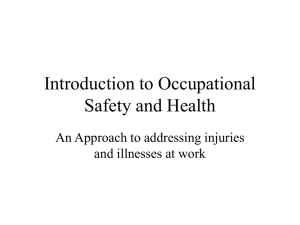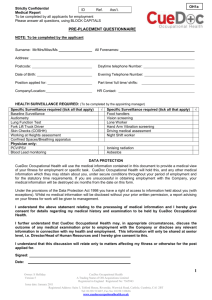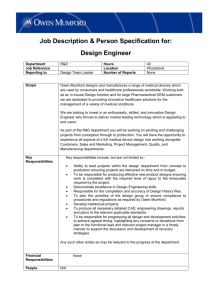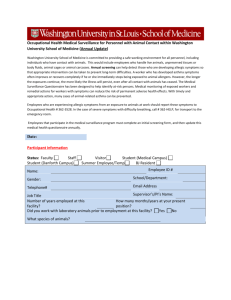Washington State: Fundamental State Occupational Safety and Health Surveillance Program Principal Investigator:
advertisement
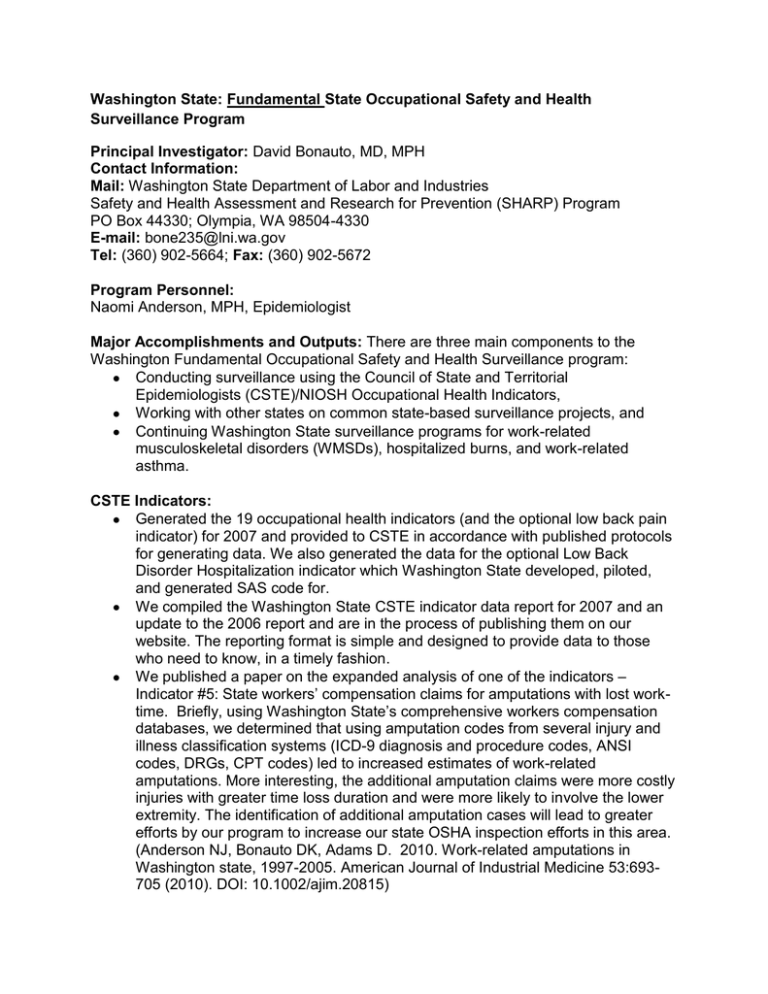
Washington State: Fundamental State Occupational Safety and Health Surveillance Program Principal Investigator: David Bonauto, MD, MPH Contact Information: Mail: Washington State Department of Labor and Industries Safety and Health Assessment and Research for Prevention (SHARP) Program PO Box 44330; Olympia, WA 98504-4330 E-mail: bone235@lni.wa.gov Tel: (360) 902-5664; Fax: (360) 902-5672 Program Personnel: Naomi Anderson, MPH, Epidemiologist Major Accomplishments and Outputs: There are three main components to the Washington Fundamental Occupational Safety and Health Surveillance program: Conducting surveillance using the Council of State and Territorial Epidemiologists (CSTE)/NIOSH Occupational Health Indicators, Working with other states on common state-based surveillance projects, and Continuing Washington State surveillance programs for work-related musculoskeletal disorders (WMSDs), hospitalized burns, and work-related asthma. CSTE Indicators: Generated the 19 occupational health indicators (and the optional low back pain indicator) for 2007 and provided to CSTE in accordance with published protocols for generating data. We also generated the data for the optional Low Back Disorder Hospitalization indicator which Washington State developed, piloted, and generated SAS code for. We compiled the Washington State CSTE indicator data report for 2007 and an update to the 2006 report and are in the process of publishing them on our website. The reporting format is simple and designed to provide data to those who need to know, in a timely fashion. We published a paper on the expanded analysis of one of the indicators – Indicator #5: State workers‟ compensation claims for amputations with lost worktime. Briefly, using Washington State‟s comprehensive workers compensation databases, we determined that using amputation codes from several injury and illness classification systems (ICD-9 diagnosis and procedure codes, ANSI codes, DRGs, CPT codes) led to increased estimates of work-related amputations. More interesting, the additional amputation claims were more costly injuries with greater time loss duration and were more likely to involve the lower extremity. The identification of additional amputation cases will lead to greater efforts by our program to increase our state OSHA inspection efforts in this area. (Anderson NJ, Bonauto DK, Adams D. 2010. Work-related amputations in Washington state, 1997-2005. American Journal of Industrial Medicine 53:693705 (2010). DOI: 10.1002/ajim.20815) Collaborations with other states Washington led nine other states to include questions on the CDC- sponsored Behavioral Risk Factor Surveillance System (BRFSS) survey to estimate the incidence of occupational injury in the employed population and the proportion of those injuries paid for by workers compensation. We completed the submission of this analysis for publication in the CDC‟s Morbidity and Mortality Weekly Report; this article will be published July 30, 2010. Continuing state-specific surveillance programs We continued with data collection and prevention efforts in work-related asthma and hospitalized work-related burns. We submitted a paper (original submission December 2009) to the Journal of Burn Care and Research (currently in final revision) that analyzes our workers‟ compensation claims for hospitalized workrelated burn injuries, and describes the prevalence of psychiatric sequelae (diagnosis of depression, PTSD, or other anxiety disorders) in hospitalized workrelated burn survivors. Plans: The Washington fundamental program was awarded a five-year competing continuation renewal. Several activities completed in last grant cycle will come to fruition in the coming year: a) peer reviewed publication of an analysis of hospitalized work-related burns and psychiatric sequelae workers‟ compensation data, b) publication of a state technical report summarizing hospitalized burn data and c) continue workrelated asthma surveillance and publication of a technical report summarizing surveillance data. Activities over the next five years will include: a) continued hospitalized burn surveillance and prevention activities (narrative & industry prevention report publications, b) continue participation in COSS and the provision of indicator data and web publication of indicator data, c) publication of the Prioritizing Industries Report, and d) further in-depth amputations surveillance activities (case investigations, publication of a narrative report and an industry prevention report). Washington State: Fatality Surveillance - Fatality Assessment and Control Evaluation (FACE) Surveillance Program Program Director: Todd Schoonover, PhD, CIH, CSP Contact Information: Mail: Washington State Dept. of Labor and Industries PO Box 44330; Olympia, WA 98504-4330 E-mail: scto235@Lni.wa.gov Tel: (360) 902-5663; Fax: (360) 902-5672 Program Personnel: Tom Sjostrom, CSP, Safety Investigator Randy Clark, Research Analyst The primary activities of the Washington FACE program are: Conducting surveillance of occupational fatalities, Developing prevention materials through investigation of occupational fatalities, and identifying risk factors to focus prevention strategies. Our FACE program provides useful data to Washington State employers, workers and government officials. Washington State Governor Christine Gregoire uses the number and rate of fatal occupational injuries to track Washington‟s progress in occupational safety and health. Our FACE program provides real-time data tracking the number of occupational fatalities in the current calendar year. The FACE program collaborates with the Washington Department of Labor and Industries to provide data and verification of worker fatalities for the Washington State‟s Worker Memorial Day. This day of remembrance raises awareness of workplace safety and is typically a subject of press reports. Annually our FACE program disseminates useful prevention materials to employers and workers. From July 2009 to June 2010, our FACE program created 9 Fatality Narratives-eight for the construction industry and one new narrative for the agriculture industry. In addition, FACE produced one Investigation Report, one FACE Fatal Facts, and six Data Summaries and distributed them via hardcopy mailing, e-mails and web postings to approximately 15,000 employers and workers. WA FACE materials were distributed at the Governor‟s Construction Safety Day and the SHARP symposium as well as to other targeted organizations. Washington FACE has accumulated a vast number of online prevention resources since its inception in September of 1997. From July 1, 2009 through June 30, 2010, there were 275,346 (a 57% increase from the previous year) downloads of FACE materials from the Washington FACE website. Our FACE program „Fatality Narratives‟ promote changes to improve safety on the job. (A FACE narrative is a description of the fatality and several key occupational safety and health prevention points). Eight WA FACE narratives characterizing fall fatalities (two of which are also available in Spanish) and one FACE Fatal Facts on Fall Hazards in the Construction Industry are currently used as supporting prevention resources for the WA State fall Protection rule. See http://www.lni.wa.gov/Safety/Topics/AtoZ/Falls/ WA FACE agriculture fatality narratives, new in 2010, have been utilized by the Pacific Northwest Agricultural Safety and Health Center (PNASH) and the WA Farm Bureau among others. PNASH has offered to translate these narratives into Spanish for even more extensive usage. These new narratives have a dedicated subscription sign-up and a quickly growing distribution list. Occupational fatality events trigger research and prevention activities in Washington State. Washington fatality data has been used by Labor Neighbor radio to advocate for safety within public service announcements targeting several high risk industries and occupations. Recent radio spots targeted preventing work-related violence and silo-related fatalities. FACE provided material used by the Washington State Department of Labor and Industries Small Business Center and the Education and Outreach team to communicate hazards to employers. A WA State annual data summary for 2009 and related supporting material was used by the WA Department of Labor & Industries to generate a press release on recent cases and prevention strategies for workplace violence-related fatalities, which was picked up by several local and regional publications. Plans: The Washington FACE program was funded for an additional five year period from 2010 – 2015. The Washington Fatality Assessment and Control evaluation (FACE) program plans to publish two Fatal Facts, two investigation reports, and update several data summaries in the upcoming year. The Fatal Facts reports will focus on fatalities to foreign born workers and fatalities to Hispanic workers in Washington State over the past decade. The currently planned investigation reports involve a worker killed when struck by a rack used for handling and transporting plate glass and mirrors and a construction worker who died after a fall from a building while working on a cellular antenna. Data summary updates will include fatal incidents in the construction industry, a summary of fatal incidents by industry, and a summary of fatal incidents with Hispanic victims. The FACE program also plans to continue providing a quarterly listing of Washington State occupational fatalities on the FACE website. WA FACE is also developing an online survey evaluation tool that will eventually be linked from each specific FACE product. Washington State: Trucking Injury Reduction Emphasis through Surveillance (TIRES) Program Director: Barbara Silverstein, PhD, MPH Contact Information: Mail: Washington State Department of Labor and Industries PO Box 44330; Olympia, WA 98504-4330 E-mail: silb235@Lni.wa.gov Tel: (360) 902-5668; Fax: (360) 902-5672 Program Personnel: Caroline Smith, MPH, Epidemiologist Jena Pratt, Research Investigator Fabiola Gonzalez, Safety and Health Specialist Scott Edwards, Safety Engineer Kyung Han Kim, Research Ergonomist The Washington State trucking industry has some of the highest rates of work-related injuries and highest workers‟ compensation claims costs, however very little is being done to address injuries other than those caused by motor vehicle collisions. The most common and costly injuries in trucking are musculoskeletal disorders, falls, motor vehicle collisions and injuries from being struck by or against an object. Increasing knowledge: TIRES develops educational materials to meet the needs of industrial safety personnel in the field. For the period from July 1, 2009 to June 30, 2010, these include: Online simulation training tool - Interactive, educational resource to be used by drivers and training personnel, calculates the forces involved in jumping from the truck cab or trailer versus exiting using 3 points of contact. The TIRESPIN newsletter - Introduces and educates managers and safety personnel on the magnitude of specific injury types. 2 produced. True story narratives – Actual stories of Washington workers injured on the job. Includes injury prevention tips. 2 produced. Tip sheets – Injury prevention tips for specific scenarios. 5 produced. Posters – Eye catching and educational posters for employee awareness. 6 produced. Short reports – To educate employers on the topic addressed in the accompanying documents. 2 produced. Peer review journal article – Gonzalez, F. Smith, C. Silverstein, B. Occupational Injury Surveillance of Truck Drivers in Washington State. American Journal of Industrial Medicine (Submitted June 2010.) Impact: Our educational materials promote occupational safety and health within the industry. During the period from July 1, 2009 – June 30, 2010 there have been nearly 80,000 downloads of our TIRES educational materials. The online simulation tool has been downloaded 1,955 since it was released in January 2010. Several industry safety professionals from all over the country have requested it for use in their trainings. Building a network of Trucking Companies and Drivers for Occupational Safety and Health We have produced an interactive web site where industry stakeholders can download free educational materials or share their own success stories. www.KeepTruckingSafe.org Impact: 88% of the KeepTruckingSafe.org internet users have included our website on their favorites list over the past 6 months. 327 trucking industry employers are now receiving our TIRES E-newsletter that contains links to our safety publications. Washington‟s major trucking industry groups, the Washington Trucking Associations and the Washington Refuse and Recycling Association have linked to our website. Conclusion: TIRES has listened to stakeholders to develop useful, relevant materials for safety training, filling an educational gap in this important industry by focusing on the most common and costly injuries in the industry: slips, trips, and falls, musculoskeletal disorders, and struck by injuries. We responded to flat budgets and state budget cuts by transitioning to a collaborative web site and electronic newsletter (TIRES E-news) to reach the industry instead of mailing printed materials. Additionally, we used the venue of the Washington Labor & Industries web site for safety materials. We responded to stakeholder feedback by transitioning away from safety videos and instead developed an online training simulation tool. We have created brand recognition for TIRES and developed a presence in the industry by attending events such as the World‟s Largest Truck Convoy to benefit the Special Olympics and the Washington Truck Driving Associations‟ Truck Driving Championships. We are completing our Safety Program template for use by small trucking companies. This will be launched in our TIRES E-news. Plans: TIRES has received Cooperative Agreement funding to use what we have learned over the last 5 years from surveillance and stakeholder input to focus on the activities that cause the majority of injuries in the trucking industry: loading/unloading, exit/entry from the cab or trailer, securing a load, walking around the job site. Over the next 5 years, we will continue to reach the trucking industry, both locally by participating in Washington trucking events, and nationally using online tools such as simulations, the TIRES E-news and social media. Washington State: Pesticide Illness Surveillance Identifying Preventable Causes of Pesticide-Related Illness among Agricultural Workers Principal Investigator: Joanne Bonnar Prado, MPH Contact Information: Mail: Washington State Department of Health Pesticide Illness Surveillance and Prevention Program PO Box 47846; Olympia, WA 98504-7846 E-mail: joanne.prado@doh.wa.gov Tel: (360) 236-3172; Fax: (360) 236-2261 Program Personnel: Barbara Morrissey, Toxicologist Luis “Tito” Rodriguez, Public Health Advisor Jennifer Sievert, Public Health Advisor Major Accomplishments: Completed analysis of root causes of pesticide illnesses in agricultural workers associated with personal protective equipment (PPE) and pesticide drift. Collaborated with University of Washington, Pacific Northwest Agricultural Safety and Health Center (PNASH) to integrate DOH findings from root causes study, with data from: o Worker Protection Standard (WPS) inspections conducted by the Washington State Departments of Labor and Industries (L&I) and Agriculture (WSDA), o Surveillance of cholinesterase depression in pesticide handlers conducted by L&I Cholinesterase Monitoring Program, and o Study of risk factors associated with cholinesterase depression in agricultural workers conducted by the University of Washington. Applied this combined data to coordinated prevention outreach activities to agricultural employers, supervisors and pesticide handlers. Outcomes: The final report titled “Contributing Factors to Pesticide-Related Illness among Agricultural Workers (2003-2008)” was published within the DOH Pesticide Incident Reporting and Tracking Panel Annual Report and provided to NIOSH and EPA. Results of the study were shared with pesticide handlers and other farm workers during pesticide licensing trainings and formed a framework for obtaining their feedback on prevention recommendations. At the start of each of seven trainings, DOH presented findings of the root causes analysis, in Spanish to the assembled audience. Following the presentation and a brief question and answer period, audiences, consisting of pesticide handlers and farm supervisors, were divided into small groups and asked to participate in discussion about the root cause analysis. Their views about the information and brainstorming of barriers to identified “best practice” behaviors were delineated and documented in Spanish. This year the results of the analysis of root causes were shared with others as follows: Presentation to health care providers at the Western Migrant Stream Forum. Presentation to growers and farm supervisors at the Washington State Annual Agricultural Safety Day. Discussed findings and shared a PowerPoint presentation with representatives of the WA State Farm Bureau. The Farm Bureau was able to reach over 200 farm workers, pesticide handlers, farm supervisors and owners, during presentations at 17 constituent meetings. Presentation at SENSOR-Pesticides Winter Scientific Meeting. Presentation at the Council of State and Territorial Epidemiologists (CSTE) annual meeting. Plans: WA Pesticide Program was successful in its application for NIOSH support for pesticide surveillance activities during the grant period 2010-2015. During this period we plan to maintain and improve our pesticide-illness surveillance program. We plan to: Investigate reports of illness and improve case identification of occupational pesticide poisoning by using L&I improvements in classification of pesticide exposures. Pilot the inclusion of disinfectant-related illness into our surveillance program. Improve the efficiency of our program by adopting the SPIDER database. Support and participate in pesticide-illness prevention activities in coordination with stakeholders and partner agencies. Assist CDC-labs and others who are involved in pesticide research and illnessprevention through sharing our data, and providing guidance. In addition, there is likely to be a peer reviewed publication of root causes of illness among agricultural pesticide handlers in the upcoming years.
